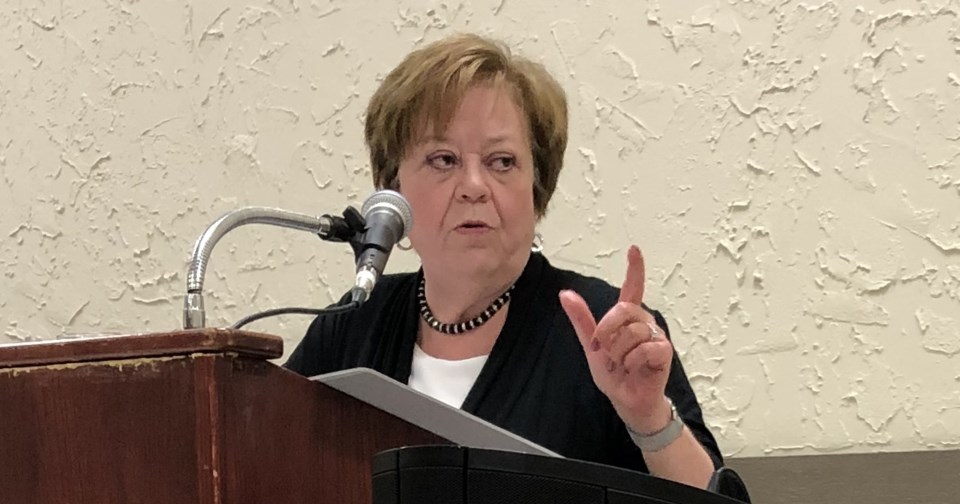HUMBOLDT — Finance minister and Humbolt-Watrous MLA Donna Harpauer gave a group of Humboldt business leaders more insight into the province’s finances last week.
Harpauer was a guest speaker at a Humboldt Chamber of Commerce luncheon on July 18.
She brought with her a list of what keeps her up at night: trade, operating costs and debt.
On trade, which Harpauer called her number-one issue, she talked about relationships with China and India as well as the US-Canada-Mexico Agreement (USCMA).
“There is no doubt the what’s happening with China is going to affect this province,” Harpauer said. “Canada is being held as collateral damage, quite frankly, with the trade war between China and the US, which is really unfortunate. And Saskatchewan, especially in the area of canola, is being disproportionately affected because we are the number-one producer of canola.”
Although China is taking no action on uranium and potash yet, Harpauer said she worries that continued trade issues might affect these markets.
“That is a huge concern because those markets are extremely important to us,” she said.
Harpauer said that Prime Minister Justin Trudeau’s visit to India in 2018, where he “perhaps didn’t follow what’s expected when you do business to other countries,” led to Canada being shut out of a number of exports to the country.
She called progress on the USCMA “an interesting, rocky road,” and said that while some tariffs have been listed, there’s still uncertainty around the trade relationships.
“We’re not ratified yet,” she said.
As an export-reliant province, Harpauer said, “We need to be competitive in order to attract investment.”
And while Saskatchewan is keeping provincial taxes low, she said, federal taxes are no longer competitive.
“The US dropped their taxes, and the federal government did not,” she said. “And so we’re not competitive on that front.”
Harpauer said the cost of power generation in Saskatchewan is expensive and just changed a week and a half ago.
As well, “the federal government is changing regulations again, and it’s going to affect our natural gas power generation.”
She also pointed to payroll and health care costs as pressures on the provincial budget.
“The number-one expense in government by far is payroll,” she said. “And that’s payroll to frontline services. That’s our doctors, our nurses, our teachers, our long-term care providers, and the list goes on and on.”
A number of tables are open right now on collective bargaining, she said, and their ratification could lead up to an additional $500 million required for payroll.
Harpauer said despite these pressures the Saskatchewan government tabled a balanced budget in March and has maintained a triple A credit rating.
“In every single indicator, we are managing the debt,” she said. “We are in a stronger fiscal position than we used to be, even though the debt load is higher.”
Harpauer described how resource revenue fell beginning in 2015, and how the government reacted as the financial situation of the province changed.
“The first year that the revenues fell … we didn’t want a knee-jerk reaction, just to start slashing programs.”
In the second year, she said, it became apparent that there was not going to be a quick recovery. “So we knew that we had to start making some very difficult decisions. And that’s when we drafted our three-year plan to get back to balance.”
The plan included the one-per-cent increase to PST in the 2017-18 budget. “We increased our tax revenue in areas of consumption, where citizens would have a choice whether or not to make that purchase.”
Harpauer said the leader of Saskatchewan’s opposition has been vocal about taxing the rich more in the province, but she defended her government’s tax policy.
She said that 17 per cent of Saskatchewan residents who pay personal income tax paid over 50 per cent of the taxes collected.
“So we do tax the rich, and we don’t want to tax them out of our province.”
Taken all together, Harpauer said the moves the Saskatchewan government has made has stabilized the fiscal position of the province.
“The 2019-20 budget, introduced in March, which is the third of our three-year plan to get back to budget, is a balanced budget. The revenue is forecast at $15.03 billion, expenses forecast at $14.99 billion, and that leaves a surplus, albeit pretty thin, at $34.4 million.”




